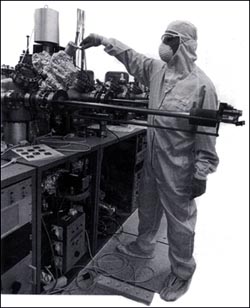
Thanks to the Weizmann Institute, Israel is now in the forefront of microelectronics research, even though such research did not even exist in this country five years ago. The change was brought about by the establishment of the Joseph H. and Belle R. Braun Center for Submicron Research, where scientists are exploring the physics of ultrasmall systems and providing the government and industry with know-how and technical support for the development of tomorrow's electronic devices.
Also thanks to the Braun Center -- headed by Prof. Mordehai Heiblum and located in the Hermann and Dan Mayer Building for Semiconductor Science -- Israel will be the venue of the 1998 International Conference on the Physics of Semiconductors.
Among the scientific breakthroughs achieved by Weizmann scientists at the Braun Center is the discovery -- made by Prof. Heiblum and colleagues -- that the mobility of electrons in semiconductors can be increased six-fold by manipulating the charges of impurities introduced into these materials. In another project, Dr. Udi Meirav and his team have achieved the long-standing goal of determining the distribution of electron flow under conditions known as the quantum Hall effect. In a third study, Prof. Israel Bar-Joseph and co-workers have clarified the behavior of electrons during metal-insulator transition, the phenomenon that underlies the operation of modern transistors.
These and other findings may provide the theoretical basis for the design of innovative ultra-tiny electronic equipment that will be faster than existing devices.
Since Braun Center scientists are conducting most of their experiments on gallium arsenide (GaAs), a superior alternative to the silicon used in advanced electronic equipment, they have gained great expertise in this material. As a result, they are engaged in collaborative projects with researchers from government and industry aimed at developing faster microwave transistors, improved optoelectronic detectors, and other devices that are based on GaAr.
Such collaborative projects help cover a substantial part of the running costs of the Braun Center, the only place in Israel that possesses molecular beam epitaxy and electron beam writing systems -- equipment required for growing GaAs crystals and miniaturizing them to submicron dimensions. In fact, the possibility of collaboration with the Center influenced the decision of Elta, a subsidiary of Israel Aircraft Industries, to launch a $15 million project for manufacturing GaAs devices.
